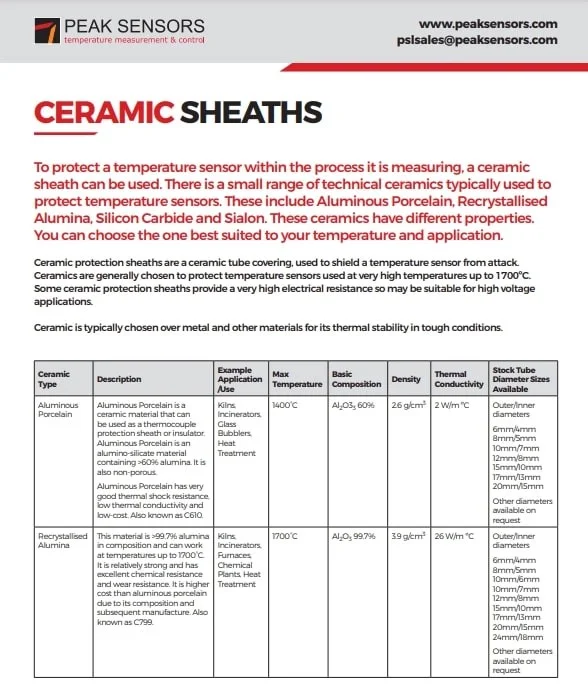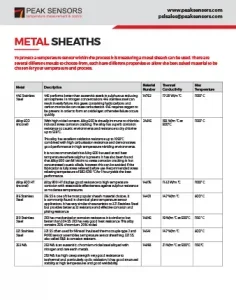What Are Protection Sheaths For Temperature Sensors?
TL;DR – Quick Summary
Protection sheaths are metal or ceramic covers that shield temperature sensors from damage, corrosion, and extreme conditions. They extend sensor lifespan, maintain accuracy, and allow use in harsh industrial environments. Choosing the right sheath material and design depends on temperature range, process conditions, and required durability.
What Are Protection Sheaths?
A protection sheath is a mechanical and environmental barrier placed around a temperature sensor. Its primary purpose is to protect the sensor’s sensing element from:
- Physical damage (impact, vibration, abrasion)
- Chemical attack (corrosive gases, liquids, or molten metals)
- Extreme temperatures beyond the bare sensor’s limits
Protection sheaths are typically made from metal alloys or ceramic materials, chosen based on the application and process environment.
Why Protection Sheaths Are Important
- Extend the service life of temperature sensors
- Maintain measurement accuracy in harsh conditions
- Reduce downtime and maintenance costs
- Enable sensor use in specialised applications such as furnaces, reactors, and pipelines
Types of Protection Sheaths
1. Ceramic Protection Sheaths
- Best for: Extremely high-temperature environments (e.g. kilns, glass furnaces, metal foundries)
- Advantages:
- Can withstand very high temperatures (well above most metals)
- Resistant to many corrosive gases and molten metals
- Limitations:
- Brittle – prone to cracking if dropped or hit
2. Metal Protection Sheaths
- Best for: General industrial use, including applications with corrosion, abrasion, or mechanical stress
- Common Materials: Stainless steel, Inconel, Hastelloy
- Advantages:
- Strong and impact-resistant
- Good corrosion resistance
- Easier to handle than ceramics
- Limitations:
- Lower maximum temperature capability than ceramics
- Certain alloys unsuitable for highly reactive atmospheres
Design Factors That Improve Protection
When selecting or designing a protection sheath, consider:
- Wall thickness – thicker walls offer more strength, but may slow thermal response
- Sealing method – welded or crimped ends prevent contamination and moisture ingress
- Tip design – closed, open, or tapered tips affect protection and sensor response time
- Length – ensures the sensing junction is positioned correctly in the process
How to Protect Your Temperature Sensor
Even with a sheath, correct installation and care are essential:
- Select the correct sheath material for temperature range and chemical exposure
- Seal properly to prevent ingress of dust, liquids, or gases
- Mount securely to reduce vibration and mechanical stress
- Use heat shields or insulation in extreme heat
- Inspect and clean regularly to remove buildup or corrosion
- Calibrate periodically for continued accuracy
- Use surge protection in electrically noisy environments
Applications
Protection sheaths are used across industries, including:
- Industrial furnaces and kilns
- Petrochemical plants
- Food and beverage processing
- Power generation (boilers, turbines)
- Aerospace and automotive testing
- Glass manufacturing
- Metal smelting and casting
Benefits of Using Protection Sheaths
- Extended lifespan for sensors
- Reliable measurements even in hostile environments
- Reduced replacement and maintenance costs
- Compatibility with thermocouples, RTDs, and other sensor types
FAQs
Q1: Do all temperature sensors need protection sheaths?
Not always. Low-risk environments may not require them, but in industrial settings, they are highly recommended to prevent premature failure.
Q2: How do I choose between metal and ceramic sheaths?
Choose ceramic for extreme temperatures and chemical resistance. Choose metal for mechanical durability and easier handling.
Q3: Will a sheath affect sensor response time?
Yes. Sheaths add a small thermal lag, but this can be minimised with thin walls or tapered tips.
Q4: Can I replace a damaged sheath without replacing the sensor?
Sometimes. If the sensor is not damaged and the design allows disassembly, the sheath can be replaced separately.
Q5: Are protection sheaths standardised?
Many follow industry standards, but custom designs are common to suit unique processes.
If you want to order a temperature sensor or you are unsure exactly what you need, get in touch and we can help you.


